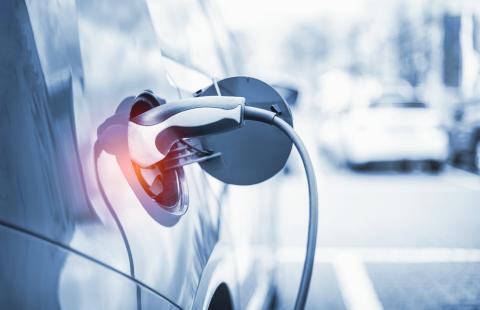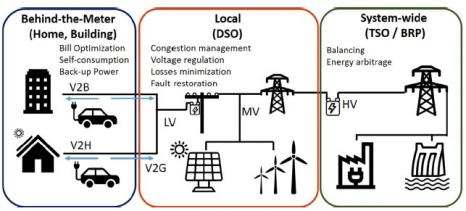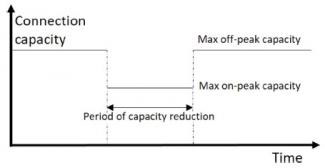
The challenge faced by distribution networks resulting from electric cars
Electric vehicles (EVs) offer many advantages, including less CO2, less noise and above all zero fine particles. The European Commission anticipates an end to the sale of combustion engines by 2035. However, the ability of the electricity grid to support the charging of a large number of vehicles is open to debate. Researchers from the Electrical and Electronic Engineering of Paris laboratory (GeePS - Univ. Paris-Saclay, CentraleSupélec, CNRS, Sorbonne Université) and the Laboratory of Industrial Engineering (LGI – Univ. Paris-Saclay, CentraleSupélec) have carried out a comprehensive review of the subject and have identified the remaining technical, economic and regulatory barriers to the successful integration of EVs into distribution networks.
Power generation for electricity grids in Europe has been historically centralised. Until recently, these grids have responded in a relatively simple way to varying and changing needs while achieving economies of scale. However, the integration of a growing number of decentralised energy production units into the grid (mainly linked to renewable energies and the development of electric vehicles, EVs) is now the challenge faced by electricity distribution system operators (DSOs) who must avoid destabilisation of the systems.
As Felipe Gonzalez Venegas from GeePS explains, “In the same way that if you turn on all the appliances in your house, the fuses blow, charging electric vehicles can create technical constraints on the distribution network, particularly at a local level, for example.”
The integration of a large number of EVs into the distribution network increases power losses and is likely to lead to congestion and voltage drops. The overloading of transformers and lines may even lead to damage and failure of equipment.
Intelligent management of charging to relieve the grid
“There are two possible ways to accommodate the charging of all these vehicles which we hope to see on the streets in five, ten or twenty years,” continues F. Gonzalez Venegas. “Either build more lines and more transformers - which is very expensive - or control the charging of EVs to limit their impact on the grid, which we call ‘flexibility’.”
Flexibility involves putting in place charging strategies, two of which have been identified in particular. These are smart charging and vehicle-to-grid charging. Smart charging “involves spreading the charging over time”, whereas vehicle-to-grid charging “is bi-directional charging where the user can charge their vehicle as well as send power back into the grid to help the network.” Like a mobile battery, EVs store energy and feed it according to demand back into the grid (V2G for Vehicle-to-Grid), a building (V2B) or a home (V2H).
Flexibility services are used for fleets of various sizes and serve different purposes according to the different scales involved. On the scale of a house or building, flexibility meets the need to minimise electricity bills or to be energy self-sufficient. At the local DSO level, it helps to manage the risk of congestion or to regulate voltage. At the national level of the Transmission System Operators (TSOs), the issue is more about energy arbitrage to ensure the balance between supply and demand.
Near-operational technology...
Together with his colleagues, F. Gonzalez Venegas set out to define the limits of flexibility by collecting results and recommendations from scientific literature and key demonstration projects in Europe dealing with the subject.
“By carrying out this appraisal of the current situation, we realised that the technical aspects were already more or less under control. The technology is available - perhaps not on a massive scale and for all vehicles - but there is on-going research on the subject.” V2G also accelerates battery wear and tear, which is a significant disadvantage for users, but the young researcher believes that the R&D teams working on this at manufacturers in particular should overcome these limitations within five years.
...but an economic and regulatory framework still needs to be worked out
With decentralised power generation, DSOs have the choice between investing in more infrastructure or using flexibility. “Today, however, DSOs are paid on the amount of network they own,” explains F. Gonzalez Venegas. “It’s therefore in their interests to build more of them.” In Europe, these regulatory frameworks are changing to encourage DSOs to implement flexible solutions and remove this significant bottleneck.
However, flexibility cannot be implemented to the detriment of users, their energy needs or the longevity of their equipment (in particular the battery). “The user must accept that charging their vehicle is controlled and, in the case of V2G, that the vehicle can feed back into the grid,” adds F. Gonzalez Venegas. “Operators need to develop facilities which are acceptable to users and value flexibility by rewarding users for services contributed to the grid, for example.”
The dynamic pricing system - a finite solution
Dynamic pricing systems enable smart charging controlled by users to take place. Variation in the energy tariff over the day directs consumption patterns towards more efficient uses. Time-of-use tariffs, for example, charge a higher tariff than the traditional fixed tariff during peak periods (peak hours) and a lower price during off-peak hours, thereby providing an incentive to shift usage.
However, “This tariff solution on its own is not sufficient because we would end up with too many vehicles connected during off-peak hours,” explains F. Gonzalez Venegas. “This is why more advanced recharging strategies are needed ”
Smart contracts - a direct arrangement between users and grid operators
Another solution for controlling EV charging is for DSOs and users to sign interruptible or variable capacity contracts. To reduce congestion, users have reduced access to the grid to charge their EVs but benefit from an attractive tariff.
“This solution is relatively easy to implement. It manages demand on the local grid, while having very little impact on users,” F. Gonzalez Venegas enthusiastically points out. “Overnight charging sessions at home usually last ten or twelve hours, while two or three hours are sufficient to recharge the vehicle. This gives users room to manoeuvre if energy trade-offs have to be made.”
These variable capacity contracts are currently being tested in the Netherlands at public charging points. For two to three hours a day during peak hours, the power supplied by the charging point is a little lower. “But the impact on users is again very small,” adds the young researcher. “Charging is slower, but generally users have a bit of leeway and charge for longer than necessary. Flexible contracts can be implemented even in this type of context.”
(Source: https://doi.org/10.1016/j.rser.2021.111060)
Intervention by third parties to create a market-based system
A final solution for implementing smart control is to use an aggregator. This is “a person or company which will control the charging of a fleet of vehicles and as a result limit the impact on the grid. This type of service provider already exists and provides services for TSOs,” adds F. Gonzalez Venegas.
An aggregator is able to manage a fleet large enough to provide flexibility on a large scale while meeting the needs of smaller scale players, as well as coordinating other distributed generation units which provide flexibility (such as stationary batteries) when EVs are not available. DSOs can then initiate local flexibility markets where several aggregators compete to provide services to the grid.
This type of system has begun to be implemented in the UK and France through flexibility tenders. As with the other systems already mentioned, this avoids investment in new infrastructure.
Reference:
- Felipe Gonzalez Venegas, Marc Petit, Yannick Perez. Active integration of electric vehicles into distribution grids: Barriers and frameworks for flexibility services, Renewable and Sustainable Energy Reviews, Volume 145, 2021, 111060, ISSN 1364-0321, https://doi.org/10.1016/j.rser.2021.111060.


